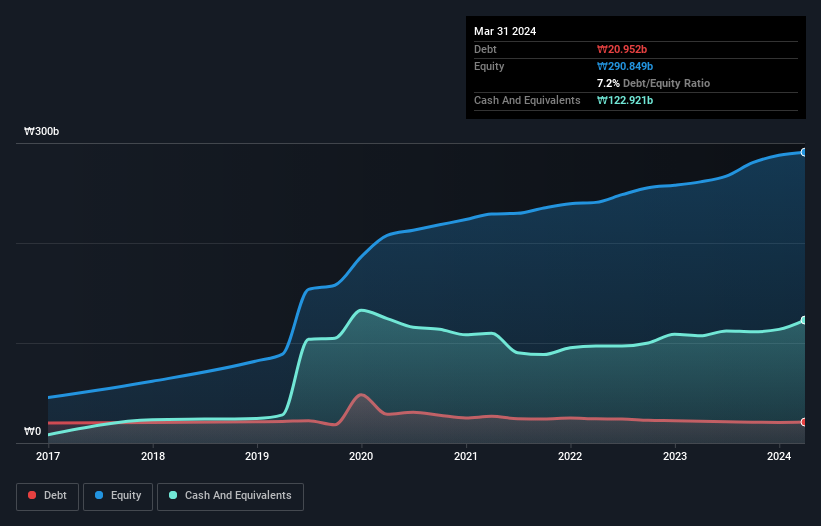- South Korea
- /
- Packaging
- /
- KOSDAQ:A251970
These 4 Measures Indicate That Pum-Tech Korea (KOSDAQ:251970) Is Using Debt Safely
David Iben put it well when he said, 'Volatility is not a risk we care about. What we care about is avoiding the permanent loss of capital.' When we think about how risky a company is, we always like to look at its use of debt, since debt overload can lead to ruin. We can see that Pum-Tech Korea Co., Ltd (KOSDAQ:251970) does use debt in its business. But should shareholders be worried about its use of debt?
What Risk Does Debt Bring?
Debt is a tool to help businesses grow, but if a business is incapable of paying off its lenders, then it exists at their mercy. If things get really bad, the lenders can take control of the business. However, a more common (but still painful) scenario is that it has to raise new equity capital at a low price, thus permanently diluting shareholders. By replacing dilution, though, debt can be an extremely good tool for businesses that need capital to invest in growth at high rates of return. The first step when considering a company's debt levels is to consider its cash and debt together.
View our latest analysis for Pum-Tech Korea
How Much Debt Does Pum-Tech Korea Carry?
As you can see below, Pum-Tech Korea had ₩21.0b of debt, at March 2024, which is about the same as the year before. You can click the chart for greater detail. But on the other hand it also has ₩122.9b in cash, leading to a ₩102.0b net cash position.

How Healthy Is Pum-Tech Korea's Balance Sheet?
According to the last reported balance sheet, Pum-Tech Korea had liabilities of ₩73.9b due within 12 months, and liabilities of ₩6.12b due beyond 12 months. On the other hand, it had cash of ₩122.9b and ₩51.6b worth of receivables due within a year. So it can boast ₩94.5b more liquid assets than total liabilities.
This excess liquidity suggests that Pum-Tech Korea is taking a careful approach to debt. Because it has plenty of assets, it is unlikely to have trouble with its lenders. Succinctly put, Pum-Tech Korea boasts net cash, so it's fair to say it does not have a heavy debt load!
On top of that, Pum-Tech Korea grew its EBIT by 38% over the last twelve months, and that growth will make it easier to handle its debt. When analysing debt levels, the balance sheet is the obvious place to start. But it is future earnings, more than anything, that will determine Pum-Tech Korea's ability to maintain a healthy balance sheet going forward. So if you're focused on the future you can check out this free report showing analyst profit forecasts.
Finally, while the tax-man may adore accounting profits, lenders only accept cold hard cash. While Pum-Tech Korea has net cash on its balance sheet, it's still worth taking a look at its ability to convert earnings before interest and tax (EBIT) to free cash flow, to help us understand how quickly it is building (or eroding) that cash balance. In the last three years, Pum-Tech Korea's free cash flow amounted to 40% of its EBIT, less than we'd expect. That weak cash conversion makes it more difficult to handle indebtedness.
Summing Up
While we empathize with investors who find debt concerning, you should keep in mind that Pum-Tech Korea has net cash of ₩102.0b, as well as more liquid assets than liabilities. And it impressed us with its EBIT growth of 38% over the last year. So we don't think Pum-Tech Korea's use of debt is risky. When analysing debt levels, the balance sheet is the obvious place to start. However, not all investment risk resides within the balance sheet - far from it. For example, we've discovered 2 warning signs for Pum-Tech Korea that you should be aware of before investing here.
At the end of the day, it's often better to focus on companies that are free from net debt. You can access our special list of such companies (all with a track record of profit growth). It's free.
New: Manage All Your Stock Portfolios in One Place
We've created the ultimate portfolio companion for stock investors, and it's free.
• Connect an unlimited number of Portfolios and see your total in one currency
• Be alerted to new Warning Signs or Risks via email or mobile
• Track the Fair Value of your stocks
Have feedback on this article? Concerned about the content? Get in touch with us directly. Alternatively, email editorial-team (at) simplywallst.com.
This article by Simply Wall St is general in nature. We provide commentary based on historical data and analyst forecasts only using an unbiased methodology and our articles are not intended to be financial advice. It does not constitute a recommendation to buy or sell any stock, and does not take account of your objectives, or your financial situation. We aim to bring you long-term focused analysis driven by fundamental data. Note that our analysis may not factor in the latest price-sensitive company announcements or qualitative material. Simply Wall St has no position in any stocks mentioned.
Have feedback on this article? Concerned about the content? Get in touch with us directly. Alternatively, email editorial-team@simplywallst.com
About KOSDAQ:A251970
Pum-Tech Korea
Engages in the manufacturing and sale of in cosmetics dispensers and containers in South Korea and internationally.
Undervalued with solid track record.
Market Insights
Community Narratives


Recently Updated Narratives

Bisalloy Steel Group will shine with a projected profit margin increase of 12.8%

Astor Enerji will surge with a fair value of $140.43 in the next 3 years

Proximus: The State-Backed Backup Plan with 7% Gross Yield and 15% Currency Upside.
Popular Narratives


MicroVision will explode future revenue by 380.37% with a vision towards success


NVDA: Expanding AI Demand Will Drive Major Data Center Investments Through 2026



